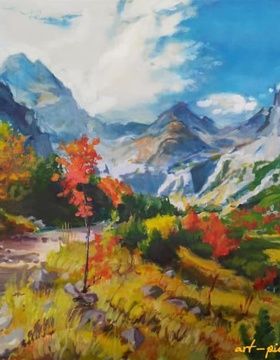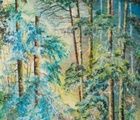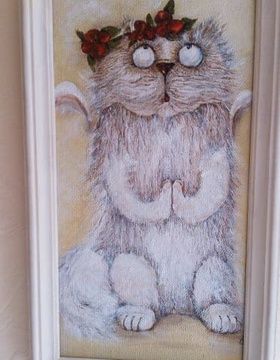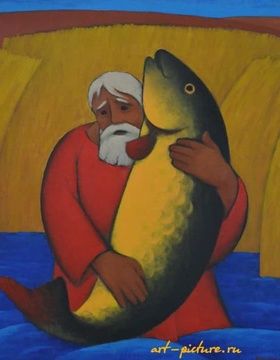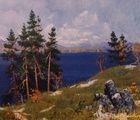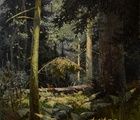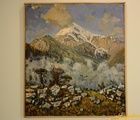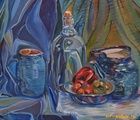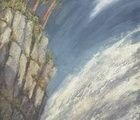
Картины маслом
Полотна художников использующих масляные краски являются самыми востребованными.
Техники
Техника а-ля прима - «по сырому», без подмалевка — при которой даже после первого сеанса художник пишет по невысохшему слою или определенным образом освежает появившуюся на нем подсыхающую пленку. Это первый и наиболее распространенный способ а-ля прима. Многие мастера стремятся писать этюды в этой технике за один прием. Можно также работать «по сырому» несколько сеансов. Чтобы слой краски медленнее высыхал, употребляют медленно сохнущие цинковые белила, а незаконченный этюд хранят в прохладном, но не сыром помещении. Появившуюся пленку на красочном слое растворяют - перед началом работы поверхность краски протирают соком лука или чеснока либо специальным лаком для живописи.
Необходимо заботиться о том, чтобы вначале работы не было слишком толстых слоев краски, особенно на первом сеансе. Нередко сначала пишут темные места теплее и светлее, а освещенные - темнее и холоднее, то есть выдерживают общую гамму этюда, а затем прописывают наиболее яркие цветовые контрасты. Самые сильные цветовые оттенки на свету и в тени выделяют в последний момент, когда работа подходит к концу.
Техника многослойной живописи основана на наслоении нескольких красочных слоев. Она отличается от письма «по сырому» тем, что каждый слой краски основательно просушивается перед нанесением последующего. Процесс работы состоит из следующих этапов: подмалевки, пастозной прописки и лессировки. В технике многослойной живописи подмалевок имеет немного иное значение, чем первая тонкослойная прописка в а-ля прима. Нередко он делается гризайлью: используются белила и какая-либо темная краска.
Иногда такой подмалевок делают по тонированному, например, по серому грунту. При этом белила для моделирования освещенных мест наносят густыми мазками, а темной краской тонким слоем прописывают тени. Далее живопись ведется полупастозно, то есть в полутонах: густыми мазками в светлых местах и тонкими слоями — в тенях. Подмалевок также можно сделать акварелью или темперой. Этими водяными красками пишут только на эмульсионном грунте. Такой подмалевок затем требует полного покрытия масляными красками, так как полученный тон будет отличаться от последующих мазков маслом. Вторая прописка начинается только после просушки подмалевка. Если он выполнен гризайлью, то вторую прописку лучше делать лессировочно.
Лессировки - это тонкие, прозрачные слои красок, наносимые на другие, уже основательно засохшие. Лессировать можно всеми красками, кроме сильнокроющих - кадмиевой, неаполитанской желтой, английской красной - а также белил. Следует также учитывать, что одни лессирующие краски прозрачны (например, изумрудная зеленая), другие полупрозрачны.
Стоит отметить, что никаких строгих рецептов наложения мазков и красочных слоев не существует. Фактуру и характер мазка следует искать в зависимости от особенностей изображаемой натуры и своих склонностей к той или иной технике исполнения работы. Так, прежде чем отвергнуть ту или иную смесь, полученную на палитре, попробуйте различные варианты наложения мазка. Иногда оттенок, казавшийся неудачным, хорошо вписывается в этюд, если положить его, например, горизонтально, а не вертикально.
Главное отличие современных масляных красок от исторических аналогов - наличие в их составе большого количества вспомогательных компонентов. Эти вещества используются для улучшения свойств красок, главным образом для ускорения их высыхания и предотвращения расслоения при хранении.
В качестве основы для картин маслом изначально служили деревянные панели, а льняные и хлопчатобумажные холсты для этих целей живописцы начали использовать на несколько столетий позже. Чтобы краска не впитывалась в основу, на поверхность холста или доски наносили слой грунта, изготовленного на основе мела или гипса. В наши дни мастера используют более практичный акриловый грунт, который быстро сохнет и легко окрашивается в разные цвета.
Основным инструментом для написания картин маслом были и остаются кисти разных типоразмеров с деревянной ручкой и ворса из шерсти (щетины) различных животных. Кроме них, живописцы также используют мастихины - особые мастерки с металлической фигурной лопаткой.
А знаменитый Тициан (Tiziano), кроме прочего, отличался от своих коллег тем, что предпочитал наносить краску на холст кончиками пальцев.
История развития масляной живописи
Самые ранние образцы масляной живописи археологи обнаружили в горах Афганистана, в Бамианской долине. Здесь, вокруг высеченных из камня статуй Будды, древние художники еще в VII веке расписали стены масляными красками. Буддийские живописцы уже тогда умели не только досконально смешивать разные пигменты, но и научились покрывать их специальным защитным лаком.
В Европе масляная живопись появилась значительно позже. Вплоть до XV века здесь господствовали темперные краски и техника энкаустики. Только в эпоху Раннего Возрождения ситуация начала постепенно меняться. Длительное время считалось, что первооткрывателем масляной живописи в Европе был Ян ван Эйк (Jan van Eyck). Но в наши дни ученые все же пришли к выводу, что гениальный голландец не был пионером этой техники, а только усовершенствовал методики работы с удобными красками и всячески способствовал их популяризации.
Из Голландии масляная живопись распространилась на остальные страны Европы и уже к середине XVI века заняла лидирующее положение среди всех используемых техник. Эта тенденция только усилилась в начале XIX столетия, когда начался массовый выпуск масляных красок в тюбиках. Художники наконец-то получили возможность с комфортом творить не только в своей мастерской, но и на открытом воздухе.
Бурное развитие химической промышленности в начале ХХ столетия способствовало появлению всевозможных разновидностей синтетических красок. Несмотря на это, масляная живопись и в наши дни остается одной из наиболее востребованных техник как среди профессионалов, так и среди начинающих художников.
